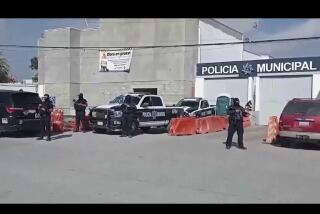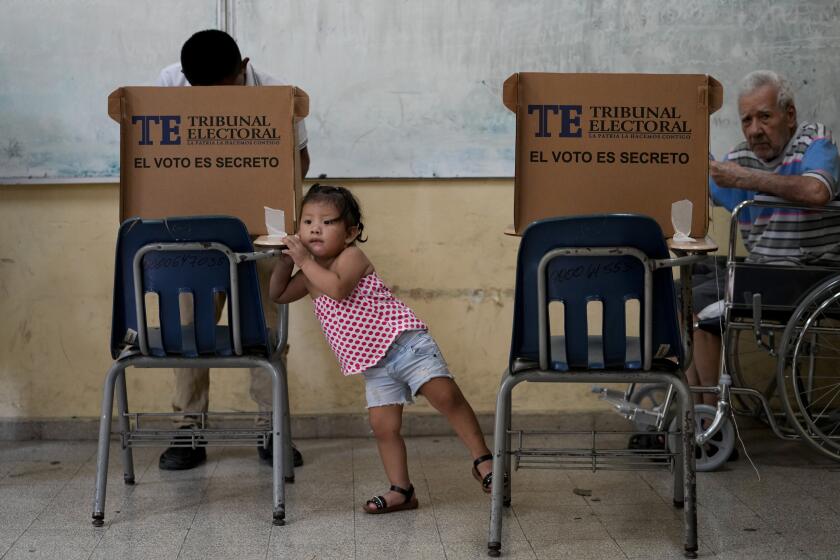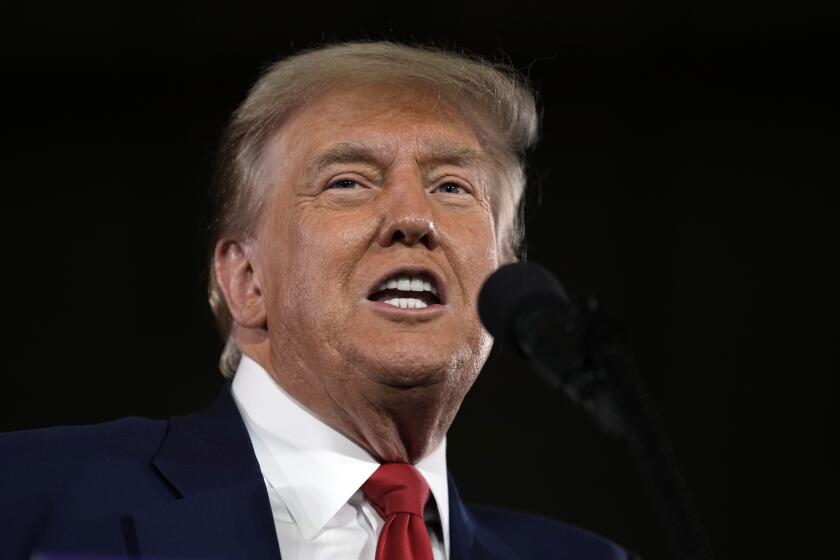Vietnam Veterans’ Memorial: ‘So All Those People Will Know’ : War: Chevron-shaped wall that has helped heal the wounds of a battle that the U.S. couldn’t win observes its 10th anniversary.
Marsha Hall stands before the Vietnam Veterans Memorial, crying for America’s fallen and once forgotten.
She is crying to remind a country that turned away from its most divisive war of the 58,175 men and eight women honored by the sleek polished black granite monument.
“Having it placed next to the Washington Monument, it’s so fitting,” she said. “This is going to be here forever so that all those people will know.”
For many, the 492-foot, chevron-shaped wall--dedicated 10 years ago this week--has helped heal the wounds of a war the United States couldn’t win and most people wanted to forget.
While memorializing the dead, it also is a tribute to the living veterans shunned when they returned home from the 14-year war of attrition that was America’s longest.
Reading the names etched on the 140 granite tablets is a roll call of the agony of war.
“There were a lot of people that were killed and a lot of people that were ignored when they came home,” said Hall, 42. “That’s the reason we need to have this. It shows the world that they fought and died for this country even though we didn’t win the conflict which was the problem.”
One of the 58,183 names belongs to Wilson Halley; he was a high school friend of her husband, James. As his wife watches, James Hall runs his hand across Halley’s name and then takes a photo of it. His father and Halley’s mother were teachers together at Chestertown High School in Indiana.
The ritual is similar for Jim Robbins, a 41-year-old Vietnam veteran from Centralia, Ill., who uses pencil and paper to make rubbings of names for friends back home whose relatives were killed.
To him, the rows of names, taken together, are staggering.
“It’s just overwhelming,” Robbins said, “to see what it cost in lives.”
Susanna Williams of Toronto, who was in her teens during the war, is touching some of the names, gliding her hands over the engraved letters that signify stranger after stranger.
“I wanted to get a little closer somehow,” she said, “and that’s about as close as I’ll ever be able to get.”
For her husband, Robert, the memorial is simple but compelling, stark but eloquent, its black granite a mirror that reflects the faces of its visitors, the American flag and the burnished colors of fall. “It really comes at you to see all those names,” he said.
In the 10-year span of the Wall’s life, 30 million people have come to give testament.
Old and young, comrades in arms and generations born after war’s end, sons and daughters, mothers and fathers, from sea to shining sea, they come to somehow make peace with their losses and to leave thousands of mementos reflecting their sorrow.
Those mementos, more than 30,000 of them, include letters, photos, medals, dog tags, cans of beer, clothing, teddy bears, Christmas trees, POW-MIA bracelets, and even a tiger cage made from bamboo similar to those used by the North Vietnamese as holding cells for American prisoners of war.
“That’s a statement of a feeling of loss,” said John Wheeler, a West Point graduate who was among the veterans who spearheaded the memorial. “It’s an act of trust. And it’s trying to reach across the vale of death.”
More than 500 of the items are on exhibit at the Smithsonian Institution’s National Museum of American History to commemorate the memorial’s 10th anniversary. The exhibit, “Personal Legacy: The Healing of a Nation,” will run through June 7.
“Most of these items were a part of someone’s life that say, ‘This was a very special life that was lost,’ ” said Leah Miller, national director of Beyond the Wall Inc., a nonprofit organization that raised funds for the exhibit. “The memorial touches everyone. It’s a reflection of life as you look into the Wall.”
The Wall was built not by the government, but by veterans, who raised $8.4 million. It was a way of acknowledging themselves after years of isolation, pain and loneliness; it was dedicated nearly 10 years after the United States ended its military intervention in Vietnam.
“It’s home,” said John Truesdale, a 45-year-old homeless veteran who sells T-shirts at the monument for The Real World Foundation, a nonprofit group that raises funds for homeless Vietnam veterans and their families.
Truesdale points to a T-shirt he designed bearing the words, “Vietnam affected an entire generation.”
“For some, it’s not over and cannot be forgotten,” he said. “People that come through here that are veterans have all gone through some of the same stuff I have. It’s comforting. . . . I can come down here and help collect myself.”
The memorial is a belated thank-you and a salute for a job well done in a war where there were no heroes, no welcome-homes, no parades, no brass bands, no bunting, no yellow ribbons.
As Leah Miller’s ballad “Coming Full Circle” proclaims:
We join in thanksgiving,
For all you have done,
Gave peace to the living,
Through battles you won.
We stand and salute you,
Our flags raised on high,
The red, white and blue,
Touched with stars from the sky.
In coming full circle,
We give you our hand.
To ask forgiveness.
For now we understand.
Coming full circle, indeed. The Vietnam Veterans Memorial is the most visited of monuments in Washington. It stands on the National Mall, 10 feet tall at its center, tapering off at each end. One arm points to the Lincoln Memorial, the other to the Washington Monument.
“I think it’s given both Vietnam veterans and the nation a place to reflect on a very difficult era,” said Jan Scruggs. “It has become a symbol of unity and reconciliation for the country.”
Scruggs, now 42, conceived the idea for the memorial in 1977 while doing graduate research at American University in Washington on the psychological problems facing fellow Vietnam veterans.
He recommended it in testimony before the U.S. Senate that year, but the idea drew little enthusiasm. Two years later, Congress still hadn’t done anything, so Scruggs decided to do it himself.
He thought only $1 million would be needed, but there was little interest among a public still in denial. Only $144.50 trickled in during the first six weeks, but contributions swelled after the proposal received national publicity.
The contest to design the monument drew more than 1,400 entries and was won by Yale architecture student Maya Ying Lin, the 22-year-old daughter of two Chinese scholars.
Some conservative elements opposed her nontraditional design of the inverted “V,” arguing it did not do justice to the soldiers’ bravery and was too reminiscent of the peace sign flashed by anti-war protesters. Others called the memorial a “black gash of shame and sorrow” and a “tombstone.”
To appease them, a more traditional 7-foot bronze statue of three heroic servicemen and a flagpole were added to the memorial in 1984.
Coming full circle.
“To veterans,” said Scruggs, “it’s given them the welcome home that they never got. It’s given them a sense of pride. People now understand their sacrifices and difficulties.”
Monetary contributions for the memorial can be sent to the Vietnam Veterans Memorial Fund Inc., 815 15th St. N.W., Suite 601, Washington, D.C., 20005.
Monetary contributions for the support and maintenance of the Smithsonian exhibit of memorabilia can be sent to Beyond The Wall Inc., P.O. Box 221616, Chantilly, Va. 22022.
More to Read
Start your day right
Sign up for Essential California for news, features and recommendations from the L.A. Times and beyond in your inbox six days a week.
You may occasionally receive promotional content from the Los Angeles Times.






